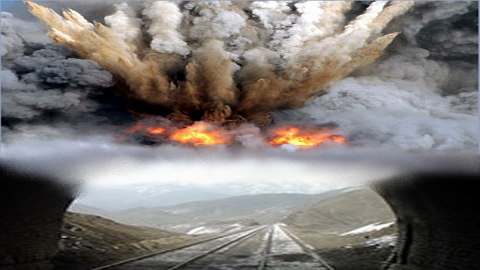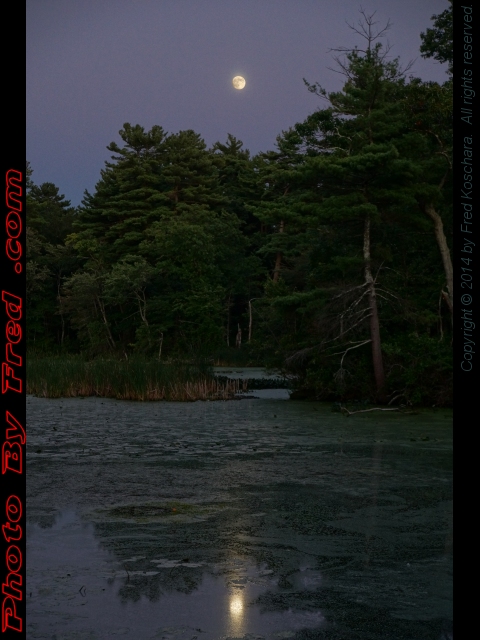Happy #SputnikDay!
Oct. 04, 2017, under events, history, space t/e/d
Today is the 60th anniversary of the launch of Sputnik 1, the first satellite humanity put into orbit, launched 4 October 1957 from Baikonur at 10:28pm Moscow time.
It’s a national holiday for those of us who are citizens of the #L5Nation, celebrate it appropriately!
This is picture of the day # 4727 on PhotoByFred.com
From the Space History Newsletter:
Sputnik 1 was the first artificial satellite successfully placed in orbit around the Earth. (The Russian word “Sputnik” means “companion,” “satellite” in the astronomical sense.) In 1885, in his book “Dreams of Earth and Sky,” Konstantin Tsiolkovsky had first described how such a satellite could be launched into a low altitude orbit. Coming at the height of the Cold War, the launch caught the West by surprise, and began the space race by galvanizing interest and action on the part of the American public to support an active role in space research, technology, and exploration.
Sputnik 1 was launched on an R-7 (ICBM) booster from Baikonur Cosmodrome at Tyuratam (370 km southwest of the small town of Baikonur) in Kazakhstan, then part of the former Soviet Union, on 4 October 1957 at 10:28:04 pm, Moscow time. It was the first in a series of four satellites in the Soviet Sputnik program, a contribution to the International Geophysical Year (1957-1958). Three of these satellites (Sputnik 1, 2, and 3) reached Earth orbit.
The Sputnik 1 satellite was a 58.0 cm (14.7 inches) diameter aluminum sphere that weighed 84 kg (184.3 lb) with four whip-like antennas that were 2.4-2.9 meters long. The antennas looked like long “whiskers” pointing to one side. The spacecraft obtained data pertaining to the density of the upper layers of the atmosphere and the propagation of radio signals in the ionosphere. The instruments and electric power sources were housed in a sealed capsule and included transmitters operated at 20.005 and 40.002 MHz (about 15 and 7.5 meters wavelength), the emissions taking place in alternating groups of 0.3 seconds duration. The downlink telemetry included data on temperatures inside and on the surface of the sphere.
Since the sphere was filled with nitrogen under pressure, Sputnik 1 provided the first opportunity for meteoroid detection (no such events were reported), since losses in internal pressure due to meteoroid penetration of the outer surface would have been evident in the temperature data. The satellite transmitters operated for three weeks, until the on-board chemical batteries failed on 26 October 1957, and were monitored with intense interest around the world.
The orbit of the then inactive satellite was later observed optically to decay 92 days after launch (4 January 1958), after having completed about 1400 orbits of the Earth over a cumulative distance traveled of 70 million kilometers. The orbital apogee declined from 947 km after launch to 600 km by 9 December.
The Sputnik 1 booster rocket also reached Earth orbit and was visible from the ground at night as a first magnitude object, while the small but highly polished sphere, barely visible at sixth magnitude, was more difficult to follow optically. Several replicas of the Sputnik 1 satellite can be seen at museums in Russia and another is on display in the Smithsonian National Air and Space Museum in Washington, DC.
We are going to run out of oil. Before that happens, we MUST have a replacement source of energy and feed stock for our civilization that has become so dependent on plastic. The time to act is NOW!! Please visit SpacePowerNow.org to help build a solution.
#BlowUpTheTunnel – visit my campaign and help get my book written!
#BlowUpTheTunnel – I’m writing a book
Sep. 29, 2017, under call to action, progress reports
I launched my #BlowUpTheTunnel GoFundMe campaign, looking for support so I can spend my time writing a book (about a long term energy solution that will create thousands of jobs) instead of going to another 9-to-5. Please check it out now at https://www.gofundme.com/blow-up-the-tunnel and add your support:
We’re going to run out of oil .
You may not see it, your children might not, but your grandchildren probably will.
When we do, two things are going to happen: Everything that depends on cheap, abundant energy will become impossible, and there will be no more plastic. Those electric hand dryers in rest rooms – where do you think the electricity for them comes from? Electric airplanes could provide local air travel – if there’s electricity – but transcontinental or transoceanic travel? Forget about it! Washing machines? Electric stoves? TVs? Cell phones? The Internet? They all need cheap, readily available electricity. “But we actually don’t need plastic” you might say. Really? Look around you, and notice where plastic is used – cars, furniture, cell phones, ATMs, computers, disposable forks, spoons and cups – the list goes on and on and on: I’ll bet there’s not a room in your house that has no plastic in it.
Eventually the demand for oil and oil products is going to exceed the total production capacity. When that happens, civilization will start to collapse. Look forward to widespread starvation … rampant civil unrest … WAR … and if things get really out of hand, a nuclear winter that makes life itself “difficult” anywhere on Earth.
I’m sure you want to save your descendants from this horrible fate. I’m asking you to help me save the future of mankind: There is a way to avert this disaster, but only if we act now:
Fossil fuels – oil, coal, gas – stored the Sun’s energy falling on the Earth in the past; in essence, they are fossilized sunshine. Over the course of the last century and a half, we used up a large portion of the Sun’s energy stored over millions of years, and the gas tank is getting low.
The only feasible energy source to replace oil is large scale direct collection of solar power: The Sun ultimately powers everything on Earth. However, trying to collect solar power at the Earth’s surface to run our entire modern civilization is not practical: In any given location, the Sun is overhead only part of a day. It may be obscured by clouds in the air or snow on the ground. Solar collectors take up a lot of space, and the power consumed by a city far exceeds the amount of solar power falling directly on it.
Because of these problems, solar power is generally ruled out as a viable replacement for oil power. It is those very problems that make it imperative for us to build a network of solar power satellites in orbit, where the Sun always shines, and beam the power to the ground. Only then can we hope to have enough area in the collectors to gather the energy needed by a power-hungry civilization and make it cheaply available.
Oh, and don’t forget: We’re going to need to replace the source of our plastics. How is that going to happen? By using more energy, of course, to power the recycling plants that convert old plastic into new.
Building a constellation of solar power satellites will require a tremendous investment. Thousands, if not millions, of people need to work to make it happen, and the construction is not going to happen overnight. We must get started NOW or the end of civilization predicted above will befall us.
Here’s my problem, and this has happened before, too many times: I’ve gotten to where I can “see the light at the end of the tunnel.” I know if I can keep going, I’ll come out on the other side where I can “stretch my wings and fly” – to put the story together that gets this project off the ground. However, I’m fighting an uphill battle against a strong current that’s sucking everything out of me. The tunnel is channeling the flow, pushing me to return to where I’ve struggled to leave. The pressure is making forward progress impossible. I’m losing my grip. If I don’t do something to relieve the pressure, I’ll end up falling back to where I started – or further behind. It’s time to “#BlowUpTheTunnel,” to shatter the lid that’s holding me down, and to give the current somewhere to go that doesn’t involve eroding my progress.
I’m running this campaign to raise money to finance writing and publishing a book: When it’s done, my thesis will have realistic estimates of the costs involved, how many jobs will be created, and how long it will take to finish. It will define a specific course of action that we can “take to the bank” to get the funding to put the plan in motion.
For those who don’t know me personally, here’s a brief introduction:
I am a Capitalist (spelled with a capital ‘C‘, please) in that I believe that voluntary trade for mutal profit is the only proper form of human interchange: for profit because expecting to gain is a good reason for doing something; mutual profit in that both parties should enjoy a benefit; trade since interchange must be a give and take thing; and voluntary in that both parties must enter into the trade of their own free will or a crime is occurring: Initiation of the use of force (i.e., the victim is not acting voluntarily) can be shown to be the root of any act that is properly considered a crime. Trade and profit need not necessarily be goods or money, for example, the reason you feed your cat and give it a warm bed is for the love you receive in return.
Although I am a Capitalist by philosophical ideals and on moral grounds, I am not a “capitalist” according to the definition Google returns – “a wealthy person who uses money to invest in trade and industry for profit in accordance with the principles of capitalism” – I didn’t start with an inheritance of money to invest. Instead, my wealth derives from the two things that are fundamentally mine, by their nature: my TIME, and my ABILITIES. Using nothing else, I have to trade my life for everything I want or need to maintain my existence.
Most people are basically happy with their lot in life, even without a lot of money and the “life of leisure” that it could theoretically bring. An average person goes to work each day, buys a house, gets married and raises a family, and retires when they get older. The details vary, but the pattern fits the vast majority of the population. They expect to have a job, bills to pay, a fairly comfortable routine where the biggest excitement is going to football games, planning for vacation, or four-wheeling in the mountains.
Unfortunately for me, that doesn’t work: I was born with an eager mind, a fertile imagination and a creative streak that won’t quit, a desire to change the world and build a better future for all of mankind. There are times when I wish I could have a simple life, wanting nothing more than a quiet home, a family and a steady future. Those bouts don’t last long, though – usually because I find something else I want to try.
When I was five years old, I decided I wanted to be an astronaut. I’m still working on it. One way or another, nearly everything I’ve done in my life has been working toward that goal – although sometimes the connection has been “rather obscure.” A more accurate term for my goal would now be that I want to be a “space man” – I want to move off-planet (live in space), and make a lot of money doing it. Toward that end, I’m trying to attack three problems:
* providing a grid-scale energy source before we run out of oil, that energy also being needed so we can recycle resources and continue to have plastics that currently come from oil,
* building a new frontier where there is (also) space for displaced populations to resettle and grow, and for dissidents to live independent lives,
* creating planetary diversity to help ensure the survival of the human race in case something happens to make the Earth uninhabitable.I’m trying to build a system, a private enterprise run for profit that will address those three issues. Neither NASA, the ESA, nor the Russian, Chinese, Indian or Japanese space programs are going to make them happen: Any politically controlled space program cannot have the managerial stability necessary to provide general civilian access to space, except perhaps by dictatorial decree – in which case general access would probably be denied by similar decree. In addition, space programs run as not-for-profit operations have no economic incentive to succeed. They are likely to merely be an expensive play toy as long as taxpayers can be convinced to support the effort – then either discontinued or curtailed as much as is needed to quell the public outcry. A massively complex and expensive industrial system is needed to make human life possible beyond Earth’s bounds. The only way it will be built is if investors can be reasonably assured they will have a profit at the end of the day – and I believe I can make that happen.
I need to write a book that explains my plan in sufficient detail that a realistic budget can be defined, and work can be started. I expect that effort is going to take 6 months or so. While I’m writing, there will be bills to pay, groceries to buy, things that need fixing, infrastructure to put in place, etc. On top of that, I have to get the book printed once I’m done writing it. I expect the effort is going to cost about $75,000, which is the goal of this GoFundMe campaign. To top it off, getting the cash flowing is an urgent problem, because I’m already a bit behind on covering expenses.
If you read through the material I’ve written on the Space Power Now Web site (hashtag #SpacePowerNow), you’ll see I’m offering contributors there a “matching funds” deposit in an L5 National Bank account once the Bank is set up, convertible to L5 bonds once everything else is in place. I’m making the same offer here: The US dollar amount you donate to this campaign (before GoFundMe takes their fees) will get you an equal L5 dollar amount deposited in an L5 National Bank account in your name. This is in addition to all of the other benefits described for various donation levels in this campaign.
I’m trying to protect the future of humanity. I want future generations to enjoy a life that’s at least as good as what we have today. I’m asking you to help me in that effort through donations to this campaign. Please help with a donation today, for as much as you can reasonably afford.
I will sincerely appreciate any contribution made to support this campaign. Your grandchildren will thank you as well.
We are going to run out of oil. Before that happens, we MUST have a replacement source of energy and feed stock for our civilization that has become so dependent on plastic. The time to act is NOW!! Please visit SpacePowerNow.org to help build a solution.
What people will pay for …
Sep. 29, 2017, under disturbing, opinions
One of the SPAM messages I looked at today claimed to be from Fairfax Finance Limited, offering business loans and startup capital. I was suspicious if for no other reason than because the “fairfax.finance.limited@europe.com” email address looked bogus. (It turns out europe.com is a parked domain, so how would legitimate mail go through it?)
In my research to see if Fairfax Finance Limited is a real company (which it apparently is, but not related to the email), one of the links Google provided led to a page on ZoomInfo.com that appeared to have some information in an expanded view. I enabled Javascript for the page, and clicked the “more…” link to see what they had – and got a pop-up window that was trying to get me to install an executable program! Of course, I shut the window and did NOT install the program, but instead started doing some research on ZoomInfo.com itself, especially after reading the terms and conditions in the popup window that included “… in exchange for downloading and installing the ZoomInfo Contact Contributor utility which, among other features, involves sharing my business contacts as well as headers and signature blocks from emails that I receive.” (emphasis mine)
There’s a Wikipedia page about the company, saying it’s a subscription-based SaaS site that “sells access to its database of information about business people and companies to sales, marketing and recruiting professionals.” The Wikipedia page also says “Part of the company’s business model involves copying contents of web pages and storing them on its servers, and according to patent attorney Gene Quinn who runs the IPwatchdog intellectual property blog, this activity violates copyright law.”
So, from what I can see, this company builds its database by scraping public info off the Web, and by reading emails its users receive to collect contact information through software the user is expected to install and run on their system – for the sole benefit of ZoomInfo.com! Then, ZoomInfo turns around and sells that information back to those same users, and to anybody else they can get to buy it – and people pay for this??!??!?? Apparently so, since the company has been in business since 2000 and has 100-200 employees.
… and we wonder why we have so much SPAM …
We are going to run out of oil. Before that happens, we MUST have a replacement source of energy and feed stock for our civilization that has become so dependent on plastic. The time to act is NOW!! Please visit SpacePowerNow.org to help build a solution.
Yuri’s Night 2017 Boston Reception
Mar. 27, 2017, under events
I am having a reception as part of the 2017 Yuri’s Night celebrations on April 12 from 4 pm through 10 pm. The event is listed on the Yuri’s Night Web site at https://yurisnight.net/events/yuris-night-2017-boston-reception/. The flyer for the Reception can be found on the L5 Nation Web site at http://l5nation.com/news/2017YuriReception.htm. All of like mind are welcome to attend, but an RSVP will be sincerely appreciated.
Rest in peace, Gene Cernan, we will miss you
Feb. 21, 2017, under history
I originally wrote this blog post on the 24th of January, but it was lost when my blog was vandalized on the 11th of February. Fortunately, I was able to find resources that let me restore the article…
I stopped to read the space-related stuff in the latest issue of Aviation Week and Space Technology, and found some sad news: Gene Cernan died on January 16. This is the bio I added to the entry in the January 16 issue of the Space History Newsletter:
Eugene Andrew “Gene” Cernan (14 March 1934 – 16 January 2017) was the second American astronaut to “walk” in space, and the Last Man on the Moon for over 45 years.
Cernan was selected in 1963 as one of 14 in the third group of astronaut candidates. He became the second NASA astronaut to conduct a space walk during the Gemini 9 mission in June 1966, spending two hours and 10 minutes outside the cramped spacecraft. He then flew on the Apollo 10 mission to the Moon in May 1969, approaching to within 47,000 feet during the last test flight before the Apollo 11 landing two months later, in July. On his third and final space mission, Apollo 17, Cernan and geologist-astronaut Harrison Schmitt spent three days exploring the Moon’s surface, on foot and in a rover.
Apollo 17 lifted off at 12:33 a.m. EST on 7 December 1972, the only night launch of the giant Saturn V rocket ever conducted. On their way to the Moon, the crew snapped the iconic picture of the full Earth later dubbed “the Blue Marble,” which is probably the most widely distributed photograph in history, showing the blue-and-white planet floating serenely in the dark of space.
Leaving Command Module pilot John Young in orbit, Cernan and Schmitt touched down in the hilly Taurus-Littrow valley on 11 December 1972. They conducted three moonwalks, setting up experiments, collecting rock and soil samples, and photographing the barren landscape. Before following Schmitt up the ladder to the crew compartment at the end of the last excursion on 14 December, Cernan paused to read the plaque attached to the descent stage:
“Here man completed his first explorations of the Moon, December 1972 A.D. May the spirit of peace in which we came be reflected in the lives of all mankind.”
Cernan then continued: “This is our commemoration that will be here until someone like us, until some of you who are out there, who are the promise of the future, come back to read it again and to further the exploration and meaning of Apollo.”
He later continued the message on his Web site: “Too many years have passed for me to still be the last man to have left his footprints on the Moon. I believe with all my heart that somewhere out there is a young boy or girl with indomitable will and courage who will lift that dubious distinction from my shoulders and take us back where we belong. Let us give that dream a chance.”
After retiring from the Navy and NASA in 1976, Cernan went into business, and served as a TV commentator for early Shuttle flights. Politically conservative, he wrote a critically acclaimed book about his final Moon mission, appropriately titled The Last Man on the Moon, and starred in an award-winning documentary of the same name. He remained an eloquent and passionate advocate of space exploration long after he retired from NASA, testifying before Congress on many occasions, and frequently cited as an authority in print.
At the time of his death, Cernan was survived by six of the twelve men who had walked on the Moon during the six Apollo landing missions in 1969 through 1972.
The Blue Marble: 
Image courtesy NASA Johnson Space Center
See also http://www.cbsnews.com/news/gene-cernan-last-astronaut-on-the-moon-dies-at-82/
See also The Official Website of Gene Cernan
See also The Last Man on the Moon Commemorative T-Shirt
NASA’s plans, Sept. 11, 1969, and what they mean today
Sep. 11, 2014, under call to action, history, opinions, space t/e/d
In today’s Space History Newsletter, you will find this information:
Program information, NASA manned space flight after 1969
Two major directions were identified for NASA’s manned space flight in the next decade on 11 September 1969. These were further exploration of the Moon, with possibly the establishment of a permanent Lunar surface base, and the continued development of manned flight in Earth orbit, leading to a permanent manned space station supported by a low-cost shuttle system. To maintain direction, the following key milestones were proposed:
- 1972 AAP operations using a Saturn V launched Workshop
- 1973 Start of post-Apollo lunar exploration
- 1974 Start of suborbital flight tests of Earth to orbit shuttle
- Launch of a second Saturn V Workshop
- 1975 Initial space station operations
- Orbital shuttle flights
- 1976 Lunar orbit station
- Full shuttle operations
- 1977 Nuclear stage flight test
- 1978 Nuclear shuttle operations-orbit to orbit
- 1979 Space station in synchronous orbit
By 1990
- Earth orbit space base
- Lunar surface base
- Possible Mars landing
(The acronym “AAP” stands for the “Apollo Applications Program” established by NASA headquarters in 1968 to develop science-based manned space missions using surplus material from the Apollo program.)

Obviously, things didn’t work that way – in effect none of those objectives were achieved:
- the Saturn V Workshop was downgraded to Skylab, with only one workshop launched, and which was later abandoned (see 11 July 1979 Skylab fell – and the American public was robbed)
- Lunar exploration stopped after Apollo 17, never mind putting up a Lunar orbit station or surface base, foisting on Gene Cernan the dubious title of being the Last Man on the Moon
- the “low-cost shuttle” turned into the “Space Transportation System” which proved to be one of the most expensive launch options whose first flight didn’t occur until 1982 and never achieved the number of flights per year that was predicted when the project was proposed, and now discontinued, leaving America without a way to send humans to orbit on our own
- the space station in synchronous orbit never happened, and the Earth orbit space base that was supposed to be in place by 1990 devolved into the International Space Station now with a “permanent” crew of 3-6 occupants
- NASA’s initial space station operations didn’t begin until the first ISS resident crew consisting of one American (commander) and two Russians arrived in November 2000 in the Russian Soyuz TM-31 capsule
- the nuclear stage and nuclear shuttle for orbit to orbit operations have been completely abandoned
- the first human Mars landing hadn’t occurred by 1990, current predictions are that the earliest it will happen is in the 2030’s
So, what went wrong? Essentially, it boils down to politics – President Richard Nixon decided that the American public wasn’t interested in space travel, and cut NASA’s budget drastically, putting the money into the military and social welfare programs. Rather than continuing the peaceful development of space exploration and travel which was driving innovation and economic growth at an amazing pace, America was turned to a weapons manufacturer where “need” is given higher precedence than ability or reason. Among other things, that led to the September 11, 2001 attacks which destroyed the World Trade Center in New York and the subsequent “war on terror” that has stripped American citizens of so many of their fundamental rights, and to an economy on the brink of collapse due to uncontrolled expansion of the “entitlement” mentality.
Can this be fixed?
I believe it can – but not if space travel and the economy are left in the hands of the government.
Historically, two things have led to growth of the American economy – expansion into new frontiers, and innovation – creation of new industries, and new methods for existing ones. Since there are no longer any frontiers available on the Earth, there’s only one option left: Innovation is what has to drive economic growth. While there have been bursts of development such as introduction of personal computers and the whole set of industries that grew out of that innovation, and there are many fields where incremental innovation can be seen today, the whole-economy blast of innovation painted in broad strokes that led to six pairs of astronauts landing on the Moon hasn’t been seen since the government-funded space program was castrated in the early 1970’s. Developing a strong space exploration and development program, one that can and will achieve the kind of plans laid out in NASA’s 1969 outline, will require a lot of innovation, in nearly every field of endeavor. That is how to solve the economic woes the country now finds itself mired under.
Does that mean the only way we can get back on track is through another expansion of the government-run space program, by pouring more dollars into NASA? No! For example, America’s transcontinental railroad system wasn’t built as a government project – it was built by investors who recognized a tremendous market opportunity and put their money into it. The “advantage” of using tax dollars to put money into space programs is everybody participates – whether they want to or not. Wouldn’t you rather make your own choices about how your money is being invested, and where future growth will come from? I know I would – which is why I think the government needs to get out of the space “business” and let private enterprise take over.
In order for a healthy space exploration and development business to come to reality, funding has to come from everywhere – from kids bagging groceries, from multinational corporations, and everywhere in between. People and institutions that want to invest into the project need to have a mechanism for doing so, with an understandable and believable way to get a return on their investment. The L5 National Bank bonds briefly outlined on the Space Power Now Development Plan page are a system I am trying to build to make that possible: The objective is to provide investors, large and small, with a good way to invest in the future, to build a space program that will open new frontiers, solve the world’s energy problems, and boost the American economy back into high gear. Building the space business will make the military-industrial complex obsolete, creating jobs that will reduce dependency on social welfare programs, the only realistic solution to their cancerous growth.
It’s going to take political action to stop the “war on terror” and its cohorts – unconstitutional domestic surveillance, militarization of police departments, etc., and people will find it a lot easier to focus on those issues if they don’t have a failing economy about to bury them.
Space – the next frontier – the cure for what ails you!
We are going to run out of oil. Before that happens, we MUST have a replacement source of energy, and feed stock for our civilization that has become so dependent on plastic. The time to act is NOW!! Please visit SpacePowerNow.org to help build a solution.
Two particularly interesting photos in two days on PhotoByFred
Sep. 11, 2014, under art
I was really happy with the way the pictures came out for Tuesday and Wednesday:
Full Harvest Moon Rising Over Crystal Pond, Peabody, Mass.
( Click the image for a larger view )
Gull Swooping In For The Kill, Marblehead, Massachusetts
( Click the image for a larger view )
One of these days I will have time to implement a comment system so you can share your opinions about the photos. In the mean time, you can send me email…
I post a new picture each day on PhotoByFred.com. As of Sept. 11, 2014, there are 3608 daily pictures that have been displayed there since I first put the site online, on October 26, 2004. Limited edition printed copies of the photos can be purchased from LimitedEditionPhoto.com, and I’m writing a Kickstarter proposal to create a movie of the pictures that have been shown on Photo By Fred. (At 1/3 second per image, it’s going to be a 20 minute movie!) There’s a form on Photo By Fred where you can let me know if you’re interested in hearing about the movie’s progress, or comment on the idea.
We are going to run out of oil. Before that happens, we MUST have a replacement source of energy and feed stock for our civilization that has become so dependent on plastic. The time to act is NOW!! Please visit SpacePowerNow.org to help build a solution.
SPAM tools in the wrong hands
Sep. 01, 2014, under opinions
At best, SPAM tools in the wrong hands are a nuisance. An example is the user failing to configure their program properly, resulting in noise emails with Subject lines containing strings such as [?var that are easily filtered out.
August 28th was a day where some truly incompetent SPAM wannabe launched their campaign without even bothering to include a “payload” (e.g., a link to a Web site they want you to visit). On that date, I received nearly 400 SPAM messages with unpatterned From addresses and plausible Subject lines, each containing two lines of random text selections, mostly at least semi-complete sentences – and nothing else. It made finding real messages nearly impossible, and setting up an automated filter to block the noise unfeasible.
There were a couple things I noticed in the noise that made me decide I wanted to save the lot for inspection and contemplation, tidbits of at least marginally useful or interesting information, such as “PLANC is a language in the PASCAL family” (a fact I’m sure I knew at one point but had forgotten) and “Therefore, it takes an average worker over one year to make as much money as his boss makes in one day” (I’m curious to know where that conclusion came from.) I copied the messages to a file whose contents you can find here if you’re interested.
By the time I’d gone through the lot, marked them as SPAM, then went through Thunderbird’s Trash folder to delete them again to make sure I hadn’t thrown a baby out with the bath water, I’d lost a couple of hours more than I usually do to the SPAM problem for the day.
All of which begs the question “what are the right hands for SPAM tools to be in?” I had some thoughts on the matter in my previous SPAMmers are *so* stupid – or are they? post…
We are going to run out of oil. Before that happens, we MUST have a replacement source of energy and feed stock for our civilization that has become so dependent on plastic. The time to act is NOW!! Please visit SpacePowerNow.org to help build a solution.
“Gray skies blue” and “Wrong starting point” gigs on Fiverr
Aug. 24, 2014, under Web dev
I’ve posted my first two gigs on Fiverr. For the bargain price of $5 each, you can get these services.
In my first gig, I’m offering to turn gray (or grey) skies blue:
I will take your cloudy day pictures and give them a nice cloudless blue sky in the background, lighter near the horizon as you will find in nature.

( Click the image for a larger view )
In the second gig, I’m offering to create a “you don’t belong here” page for Web sites:
Every site has one or more directories where visitors should not go. For example, if you have a directory with nothing but images in it, or include scripts, you would not want someone rummaging around through them. Put this file in those directories, and if a browser finds their way into one, it will send them back to your home page without revealing the contents of the directory.
You will receive a ZIP file containing a stand-alone XHTML Strict compliant HTML page file with no external dependencies, fully customized for your site.

( Click the image for a larger view )
If you can think of any other services I could reasonably offer for $5 each, I’d be interested in hearing your ideas…
We are going to run out of oil. Before that happens, we MUST have a replacement source of energy and feed stock for our civilization that has become so dependent on plastic. The time to act is NOW!! Please visit SpacePowerNow.org to help build a solution.
Effective use of a dark stage and wearable electronics
Aug. 23, 2014, under music, special effects
I found this “Japan Tron dance” video quite interesting. Even if you’re not a techno or pop fan, you should still watch it – it’s that good 🙂
We are going to run out of oil. Before that happens, we MUST have a replacement source of energy and feed stock for our civilization that has become so dependent on plastic. The time to act is NOW!! Please visit SpacePowerNow.org to help build a solution.











